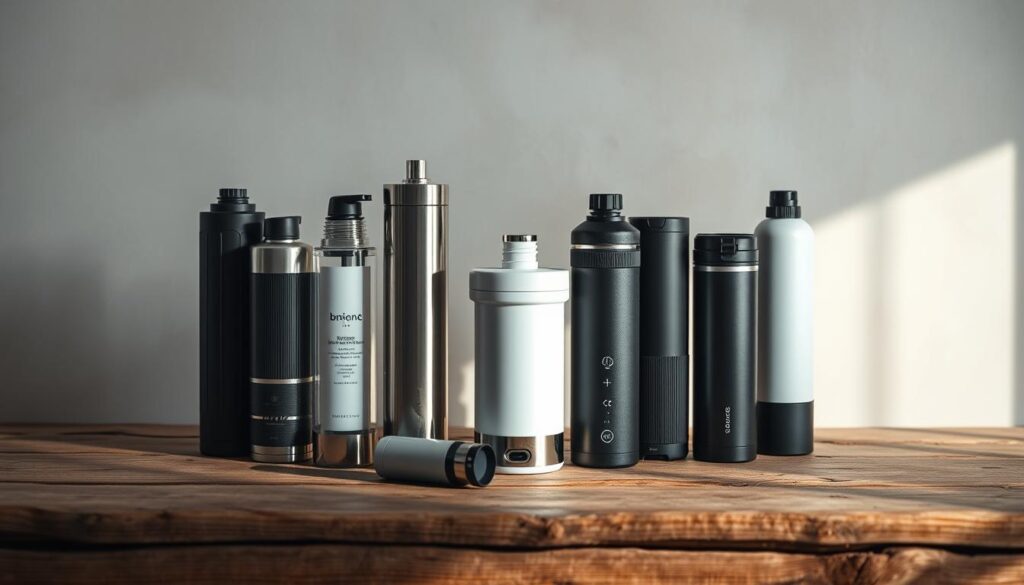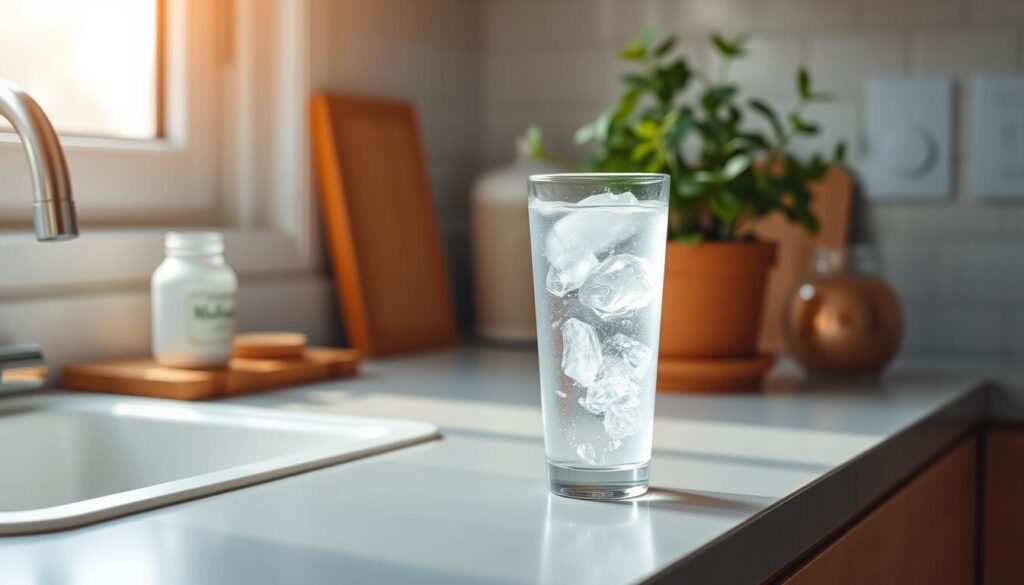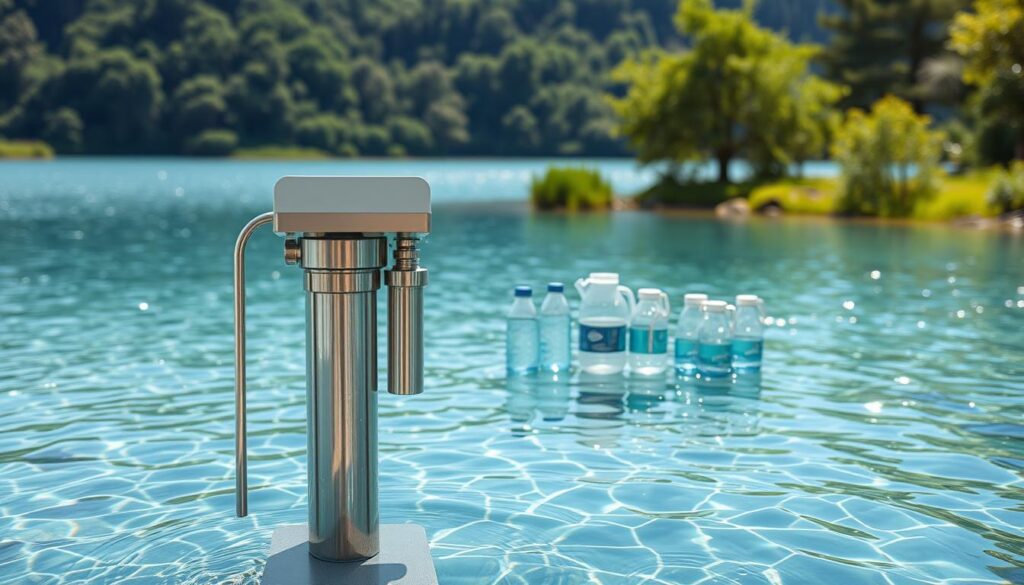As an outdoor enthusiast, I’ve learned how vital clean drinking water is when you’re out and about.
Whether you’re hiking, camping, or exploring a new country, a good portable water filter is essential.
In this article, I’ll share my favorite portable water filters and some useful tips for buying one.
Key Takeaways
- Top-rated portable water filters for outdoor enthusiasts
- Key features to consider when choosing a portable water filter
- Tips for maintaining and using your portable water filter
- Comparison of different types of portable water filters
- Recommendations for the best portable water filters for specific needs
Introduction to Portable Water Filters
Portable water filters have changed how we get clean drinking water outdoors. With more people hiking, camping, and backpacking, we need good ways to purify water. This is key for staying safe and healthy.
What Are Portable Water Filters?
Portable water filters are compact devices that clean water, making it safe to drink. They come in different sizes and types, fitting various needs. They’re vital for anyone exploring places where water might not be safe.
Why They're Essential for Outdoor Activities
Outdoor adventures often lead us to places with limited clean water. Water can have harmful stuff like bacteria and viruses. Portable water filters help by making water safe, reducing health risks.
Looking at what these filters can do helps us see their value. They remove harmful stuff from water, keeping us healthy.
| Contaminant Type | Examples | Removal Capability |
|---|---|---|
| Bacteria | E. coli, Salmonella | Highly Effective |
| Viruses | Rotavirus, Norovirus | Effective with certain filters |
| Protozoa | Giardia, Cryptosporidium | Highly Effective |
Knowing about portable water filters helps us choose the right one for our needs. This ensures we have clean drinking water outdoors.
How Portable Water Filters Work
It’s important to know how portable water filters work before choosing one for your adventures. These filters clean water by removing harmful stuff, making it safe to drink.
They use different water filtration mechanisms to do this. Activated carbon, reverse osmosis, and hollow fiber membranes are common. Each has its own strengths and weaknesses.
Filtration Mechanisms Explained
Activated carbon filters trap impurities in their pores. They’re good at removing chlorine, taste, and smell from water. But, they might not catch all bacteria and viruses.
Reverse osmosis (RO) filters use pressure to push water through a thin membrane. This method removes many contaminants. But, it can be slow and might take out good minerals too.
Hollow fiber membranes have tiny pores that block harmful stuff. This tech is often found in portable electric water filters. It’s effective and easy to maintain.
Types of Filters in Portable Systems
Portable water filters can use one or more of these mechanisms. The choice depends on what you need it for, like backpacking or camping.
Some common filters include:
- Mechanical filters, which block contaminants
- Chemical filters, which use chemicals to clean
- Ultraviolet (UV) filters, which kill bacteria and viruses with light
When looking at portable water filter reviews, think about the filter type and its effectiveness.
Factors to Consider When Buying
Before you buy a portable water filter, it’s important to know what to look for. Having clean drinking water when outdoors is key. The right filter can make a big difference.
Capacity and Flow Rate
The capacity of a portable water filter shows how much water it can hold. The flow rate tells you how fast it can filter water. For long hikes, you might want a filter that holds more water and filters faster.
For shorter trips, a smaller, more compact filter might be enough. Here’s a look at different models and their capacity and flow rates:
| Model | Capacity (Liters) | Flow Rate (Liters/Minute) |
|---|---|---|
| Sawyer Mini | 0.1 | 1 |
| LifeStraw Personal | 0.65 | 2.5 |
| Katadyn BeFree | 0.6 | 2 |
Filter Life and Replacement Costs
It’s important to know how long a filter lasts and how much it costs to replace. Some filters last longer and cost less over time. Others might need to be replaced more often, which can add up.
The Sawyer Mini filter, for example, can filter up to 100,000 gallons. This makes it a good value, even though it costs more upfront. Other filters might need to be replaced more often, which can increase their cost.
Size and Weight for Portability
The size and weight of a portable water filter are key for backpackers and hikers. They need to carry as little as possible. Filters like the Katadyn BeFree are made to be light and small, perfect for these adventures.
Think about how a filter’s size and weight will affect your packing. A smaller filter can be a big help on long trips.
Reviews of Top Portable Water Filters
Portable water filters are key for outdoor lovers. They’re perfect for hiking, camping, or backpacking. Here, I’ll look at three top picks: Sawyer Mini, LifeStraw, and Katadyn BeFree.
Sawyer Mini Water Filtration System
The Sawyer Mini is loved for its light and small size. It filters out harmful stuff like bacteria and viruses. It’s also fast, filtering 1 liter of water in a minute.
What really stands out is its long filter life. It can filter up to 100,000 gallons of water. This makes it a good value, even though it costs a bit more upfront.
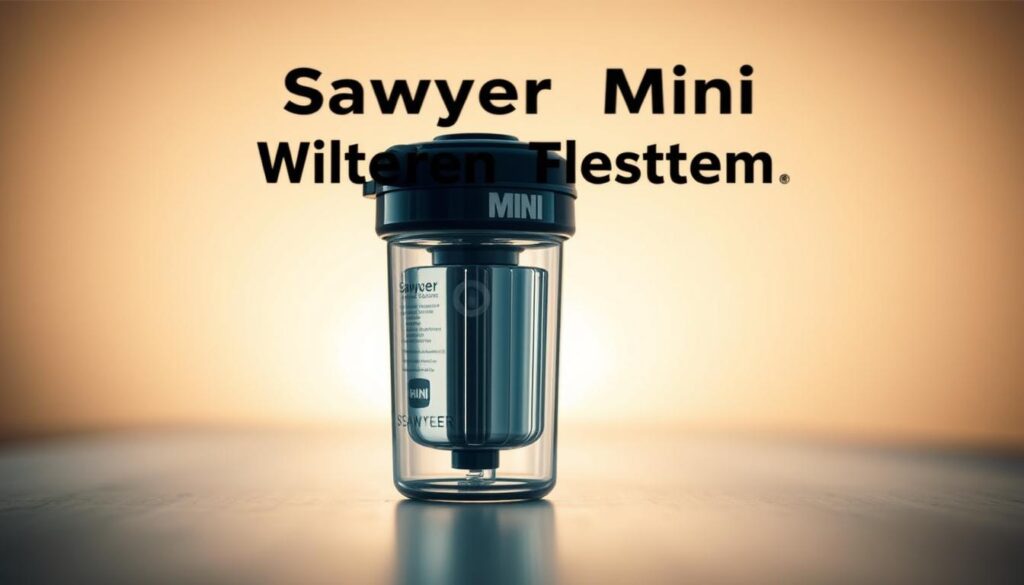
LifeStraw Personal Water Filter
The LifeStraw Personal is great for personal use. It has a hollow fiber membrane that catches 99.99% of harmful stuff. Plus, it’s easy to use and doesn’t need cleaning.
It’s also affordable and simple. This makes it a great choice for those who want a hassle-free option.
Katadyn BeFree Water Filtration System
The Katadyn BeFree is a newer but popular choice. It’s known for its innovative design and fast flow rate. It filters water quickly, in just 20 seconds.
It uses a microfilter to remove harmful stuff. It’s also compact and collapsible, making it easy to carry. Plus, it’s affordable and filters up to 2,000 liters.
Comparison of Popular Brands
Many brands are known for their portable water filters. But how do they stack up? Choosing the right one can be tough. This section compares popular brands, looking at their performance, features, and what users say.
Sawyer vs. LifeStraw: A Side-by-Side Review
Sawyer and LifeStraw are top names in portable water filters. They both make high-quality products, but they differ in key ways.
- Sawyer Mini Water Filtration System: Sawyer’s product is small and versatile. It can filter up to 100,000 gallons of water. You can use it in several ways, like with a hydration bladder or as a squeeze filter.
- LifeStraw Personal Water Filter: LifeStraw is simple and effective. It removes 99.999999% of bacteria, viruses, and contaminants. It’s a great choice for those who love the outdoors.
Sawyer filters are known for being durable and versatile. LifeStraw filters are easy to use and straightforward.
Katadyn vs. Pur: Which One is Better?
Katadyn and Pur are well-known in the portable water filter market. Each brand has its own strengths.
- Katadyn BeFree Water Filtration System: Katadyn’s BeFree filter is light and compact. It’s perfect for backpackers. It filters water fast and well, but might not last as long as others.
- Pur Water Filter: Pur filters make water taste better while removing contaminants. They often have features like micro-squeeze technology for quicker filtering.
When comparing Katadyn and Pur, think about filter lifespan, flow rate, and extra features. Katadyn is loved for its simple design and field performance. Pur is praised for improving water taste.
In conclusion, picking between these brands depends on your needs. Consider your outdoor activities, budget, and what you value in a filter.
Advantages of Using Portable Water Filters
Portable water filters are a must-have for outdoor lovers. They are perfect for camping, hiking, or traveling to places with bad water. Having clean drinking water is key.
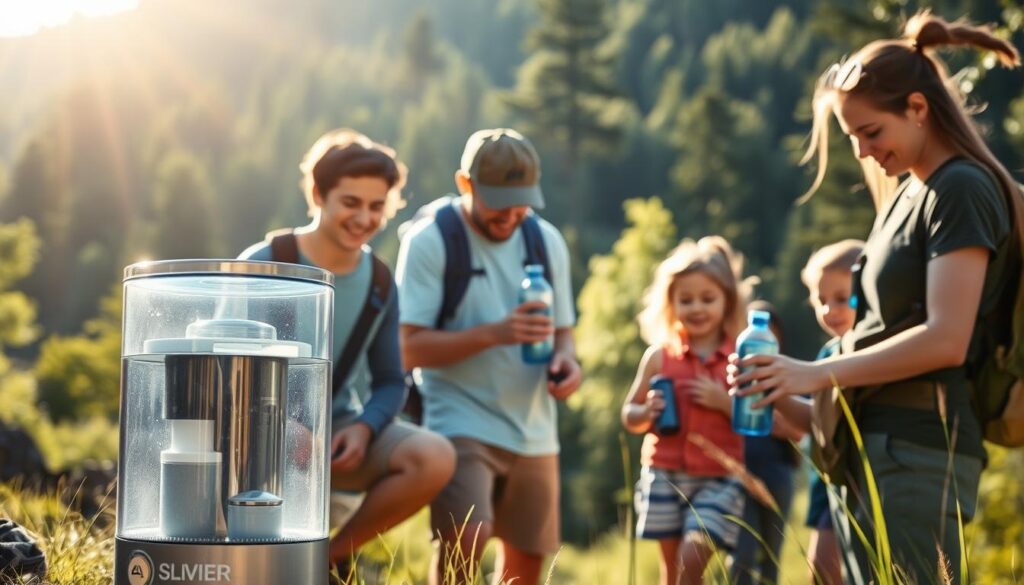
Convenience and Portability
These filters are light and small, making them easy to take on any trip. They are also easy to use. Most need little setup and care, so you can enjoy your time outdoors more.
They also give you a reliable source of clean drinking water. This means you don’t have to buy bottled water or worry about water quality. It makes your outdoor adventures better and helps the planet too.
Cost-Effectiveness Over Time
Buying a portable water filter might seem pricey at first. But think about the long-term savings. With these filters, you can cut down on bottled water costs. Bottled water can add up, so this is a big plus.
Many filters come with replaceable cartridges. This makes your filter last longer and saves money. Their durability and long life make them a smart choice for those who travel or love the outdoors.
In short, portable water filters are great for anyone who loves the outdoors. They offer convenience, portability, and save money in the long run. Getting one means you’ll always have clean water and help the environment at the same time.
Disadvantages to Keep in Mind
Portable water filters have their downsides and upkeep needs. Knowing these can help you choose the right one for your needs.
Limitations of Filtration Capabilities
Portable water filters can’t catch every contaminant. Some might miss viruses or certain chemicals. Always check what your filter can remove.
Key Considerations:
- Look at the filter’s micron rating to know its limits.
- Some filters need extra steps for full purification.
- Know the common contaminants in your water.
Maintenance and Cleaning Requirements
Keeping your portable water filter clean is key. Follow the maker’s cleaning guide and replace parts when needed. Neglecting this can harm its performance and let contaminants through.
Tips for Maintenance:
- Stick to the maker’s cleaning guide.
- Check your filter for damage or wear often.
- Keep your filter safe when not using it.
Knowing the upkeep and limits of portable water filters helps you use them wisely. They’re great for outdoor or emergency kits.
How to Maintain Your Portable Water Filter
Keeping your portable water filter in good shape is key. It helps your filter last longer and keep your water clean. Regular care ensures your water stays safe and free from harmful stuff.
Cleaning Instructions
Cleaning your portable water filter is a must. Backflushing is a common way to clean many filters. This method pushes clean water through the filter to clear out dirt and contaminants.
Also, gently scrub the outside of the filter with a soft brush. This removes dirt and sediment from the surface.
If your filter has parts that need to be replaced, like cartridges, follow the maker’s guide. Some filters might need chemical cleaning or soaking to get rid of tough contaminants.
Storing Your Filter Properly
Proper storage of your portable water filter is important. Dry the filter well before putting it away. Store it in a cool, dry place.
Don’t store it in direct sunlight or humid spots. This can cause mold or bacteria to grow.
It’s smart to keep the filter in a protective case or bag. This protects it from damage. Check your filter’s manual for the best storage tips. Different models might have special needs.
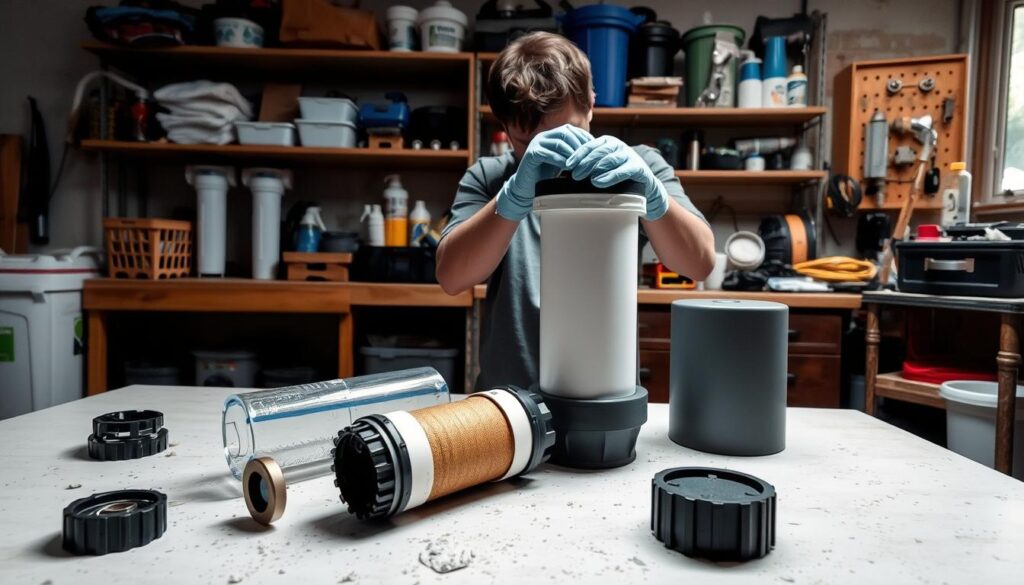
Tips for Using Portable Water Filters Effectively
To get the most out of your portable water filter, it’s key to know how to use it right. This means following the maker’s guide and thinking about the water source and how to filter it better.
Water Source Selection
The quality of your portable water filter depends a lot on the water source. Choosing the right water source can make your filter work better and last longer. Look for places with moving water, like streams or rivers, as they are usually cleaner than stagnant water.
Don’t filter water with big dirt or near pollution sources. If the water quality is unsure, think about pre-filtering or finding a different water source.
Pre-Filtering for Improved Results
Pre-filtering is a key step to boost your portable water filter’s performance. It helps prevent clogs and makes the water cleaner.
- Use a cloth or a coarse filter to catch big particles before filtering.
- Let sediment settle, then filter the clearer water from the top.
- Don’t filter water that’s very cloudy or has visible dirt.
By following these tips and being careful about your water source and pre-filtering, you can get the best results from your portable water filter. Enjoy safe, clean water on your outdoor trips.
Understanding Water Contaminants
Spending time in nature is great, but knowing about water contaminants is key. We often find ourselves near rivers, lakes, and streams. These can have harmful substances.
These harmful substances can be dangerous to our health. It’s important to know what they are and how to remove them. We’ll look at common water contaminants and why testing water quality is vital.
Common Contaminants Found in Water
Water can have many harmful substances. Bacteria, viruses, and heavy metals are common. These can cause a range of health problems, from mild to severe.
- Bacteria: Like E. coli and Salmonella, which can cause severe gastrointestinal symptoms.
- Viruses: Such as Rotavirus and Norovirus, which can lead to dehydration and other complications.
- Heavy Metals: Including Lead, Mercury, and Arsenic, which can have long-term health effects, such as neurological damage and cancer.
The Importance of Testing Water Quality
Testing water quality is essential for safe drinking water. Water quality testing checks for various contaminants. This helps us know how to remove them.
The importance of clean drinking water is huge. It’s vital for our health, even more so when we’re outdoors. Medical help might be far away.
Knowing about water contaminants and testing helps us see the value of portable water filters. These filters remove many contaminants. They’re a must-have for outdoor activities.
Real-Life Experiences with Portable Water Filters
Portable water filters really shine when you see how they work in real life. I’ve used them on many outdoor adventures. They’re super handy and always get the job done.
Personal Adventure Stories
On my hikes, I always carry a portable water filter. It’s a lifesaver when you’re not sure if the water is safe. I once used a Sawyer Mini Water Filtration System in the mountains. It worked wonders, removing all the bad stuff from the water.
“The Sawyer Mini is a game-changer for outdoor enthusiasts,” many say. And I agree. It’s lightweight, easy to use, and makes sure you always have clean water.
Feedback from Other Outdoor Enthuisiasts
Many outdoor lovers have great things to say about portable water filters. For example, a review on Survivalist Bottles talks about the LifeStraw Personal Water Filter. It’s amazing at getting rid of harmful germs.
“I’ve used my LifeStraw on many camping trips. It makes me feel safe drinking from any water source,” said a camper.
This feedback shows how important and reliable portable water filters are. They make outdoor adventures better and safer.
Conclusion: Choosing the Right Portable Water Filter
Choosing a portable water filter involves many factors. You need to think about capacity, flow rate, filter life, and replacement costs. Knowing these details helps you make a smart choice.
Key Considerations
The Sawyer Mini Water Filtration System, LifeStraw Personal Water Filter, and Katadyn BeFree Water Filtration System are top picks. Think about your needs, like outdoor activities and water sources, when picking a filter.
Staying Safe and Hydrated
With the right portable water filter, outdoor adventures become safer and more enjoyable. Whether hiking, camping, or backpacking, clean drinking water is key. By considering the factors we’ve discussed, you’ll find the perfect filter for your needs. This ensures a worry-free experience in nature.
FAQ
What is the best portable water filter for camping?
The best portable water filter for camping varies. It depends on how many people you’re with, how long you’ll be camping, and the water sources. Top picks include the Sawyer Mini, LifeStraw, and Katadyn BeFree.
How do portable water filters work?
Portable water filters use different methods to clean water. They might use activated carbon, reverse osmosis, or hollow fiber membranes. These methods remove bacteria, viruses, and other harmful stuff, making water safe to drink.
What types of contaminants can portable water filters remove?
Portable water filters can take out many contaminants. This includes bacteria, viruses, heavy metals, and more. The exact contaminants removed depend on the filter type and its mechanism.
How often do I need to replace my portable water filter?
Replacing your portable water filter depends on the maker’s advice and how much you use it. Some filters need replacing after filtering a certain amount of water. Others might need replacing after a set time.
Can I use a portable water filter for emergency preparedness?
Yes, adding a portable water filter to your emergency kit is a smart move. It ensures you have clean drinking water during emergencies or natural disasters.
Are portable water filters easy to clean and maintain?
Most portable water filters are simple to clean and keep up. Regular cleaning and proper storage can make your filter last longer and work better.
Can I use a portable water filter with saltwater or brackish water?
Most portable water filters are made for freshwater, like rivers and lakes. Using them with saltwater or brackish water might not work well and could harm the filter.
What is the difference between a portable water filter and a portable water purifier?
Portable water filters and purifiers are often confused, but they’re not the same. Filters remove particles and some microorganisms. Purifiers can take out more, including viruses and other microorganisms.
Are there any portable electric water filters available?
Yes, there are portable electric water filters. They use electricity to filter water. These are good for bigger groups or when you need to filter water fast.
Can I use a portable water filter for everyday drinking water?
Portable water filters are made for outdoor use, but some can work for daily drinking water. Make sure the filter’s flow rate and capacity meet your needs.

